In the 1800’s Britain was in the midst of an epidemic of child killing which was blamed on temporary madness following childbirth. It was said that “The mother is urged on by some unaccountable impulse to commit violence on herself or on her offspring”. The condition accounted for 15% of female asylum admissions. It was often thought that the police thought no more of finding the dead body of a child in the street than picking up a dead dog or cat. I’m sure that was not the case but it did indicate how it was becoming shockingly commonplace. Many of the mothers involved were poor working class women and often in service and most of the babies were illegitimate. It must have been in large part an act of desperation as there would be little or no help for a poor single mother.

It was the most common crime for which women were executed. Babies were poisoned, had their throats cut, they were battered to death, strangled, drowned or even thrown down the toilet. 19 women were hanged for this crime between 1800 and 1834.
In the 1840’s questions were asked in the House of Commons when Thomas Wakley MP who was also a surgeon and a coroner stated that infanticide was “going on to a frightful, to an enormous, a perfectly incredible extent….” Two decades on and the problem had reached enormous proportions and was thought of as one of the great plagues of society like prostitution, gambling or drunkenness. Dead babies were found everywhere in London. In fact the capitals canal boats were slowed down by the number of drowned infants with which they came into contact.
In a report in the Morning Post in 1864 it was stated that 3,664 inquests were held on children under one year old and of those almost 1100 were illegitimate. Deaths were caused by drowning, being burnt to death, starvation and neglect and a very large number by dubious causes in the earliest hours of life. The article goes on to say that the crime of infanticide is prevalent among unmarried mothers and hundreds of young children are thought to be “got rid of”. The remedy the writer believed could be found in religion and the example of the upper classes. This theory did not take into account the blatant fact that many of these cases were happening to young women in service in the homes of these paragons of virtue – the upper classes.
The Shields Gazette and Daily Telegraph published on Saturday 29th May 1869 had the following headline: Suspected Child Murder at Seaham Harbour. A full grown male infant was found about 8 o’clock on Thursday morning in an ash pit behind the premises of 13 & 14 William Street. Mrs. Allan, one of the tenants went to empty some ashes into the pit and saw a strange bundle. She became alarmed and called on the husband of a neighbour who informed Sgt. Revely. The police officer took the bundle to the police station and when it was opened was found to contain a new born dead infant. It was tied in a coloured cotton handkerchief with its face pressed on its chest. The coroner asked for a post-mortem to be made.
From the London Telegraph in 1877 “ …if we are to believe what medical men tell us, hundreds of helpless children are murdered each year. Just enough food is given to them, just enough attention is paid them, to ensure their lingering on for such time as shall give the death the appearance of natural causes. It is the duty of those who suspect anything of the kind to be going on to denounce the crime at once. Our first duty is to protect those who cannot protect themselves, and from this sacred charge no false sympathy must ever be allowed to move us”.
The phenomenon was not exclusive to the South of the country. Many dead babies were found in the north too and the discoveries were reported in the local newspapers.
In 1865 a man named Thomas Robinson, while at the Old Ferryboat Landing, Shadwell Street, South Shields found the dead body of a newly born male child at the edge of the river. He immediately informed the police and the body was taken to the police station. The child was thought to have been in the water only a short period of time. It was believed the baby had been strangled before being thrown into the water.
Then in 1867, once more in South Shields, it was reported that the body of a newly born female child was found by a woman wrapped in a piece of cloth on Swan’s Hill, West Holborn. The neck of the baby was discoloured. The police were making enquiries to trace the mother.
Two years later in 1869 there was a very short article about a parcel that was found lying on a heap of stones in North Shields. When it was opened it was found to contain a full grown male child with a piece of cord tied tightly round its neck, which left no doubt that the baby had been strangled as the tongue was protruding.
As two Cullercoats fishermen were walking along Whitley Sands near North Shields in December 1870, they picked up a bundle which once opened was found to contain the dead bodies of two newly born babies.
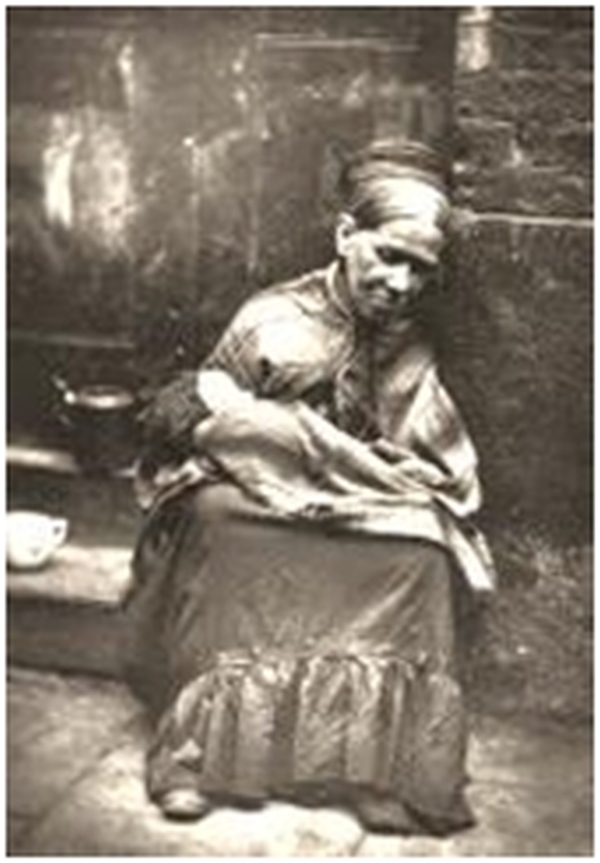
In the village of Monkton in May 1873 Jane Ann Crisp aged 19 the domestic servant of Joseph Barnes, farmer gave birth to a baby boy alone in her room. Suspicious, the mistress of the household and a fellow servant entered the room and found the child lying dead on the bed. Doctor Bridge was sent for and examining the child he found two pieces of glass above the right collar bone, and also the neck of a bottle and a cork which had been forced into the child’s mouth. The infant only lived a few minutes after birth. The police were informed and Jane Crisp was placed under surveillance. She was then taken to Durham Gaol. On the 14th July 1873 she was tried, sobbing uncontrollably and begging forgiveness before the Honourable Sir William Baliol Brett where the Jury brought in a verdict of Not Guilty of Child Murder and she was acquitted. Presumably psychological causes were brought in to her defence.

That same year in November, a baby boy was found dead between some palings near a garden in Westoe Lane, South Shields. From its appearance it was deduced that the child had been born alive but had met a violent death.
Then in May 1875 an article appeared in the Northern Echo reporting that North Shields police had apprehended a married woman named Jane Bates, wife of Walter Bates a mason employed by Tynemouth Corporation living in Trinity Street, North Shields charged with child murder. During the afternoon the body of a new born baby girl was found in the ash pit of the prisoner’s house. The body had a piece of string tied tightly round its neck. Mrs Bates was taken to the Workhouse Hospital and placed under surveillance. No motive can be found for her murdering the child.
1878 and again in North Shields the coroner’s jury brought back a verdict of wilful murder against persons unknown in the case of the death of a new born that had been placed in an out-house without clothing just after birth and left to die. The child when discovered was still breathing but tragically died shortly afterwards.
The Sunderland Echo in July 1888 ran the story of a grisly discovery within a brown paper parcel which was found by a Mrs Attanson, wife of a dancing master in the first archway of the Market in Clayton St East, Newcastle. When the parcel was opened the dead body of a young child was discovered. It was found to be a well nourished baby boy. There was a suspicious looking mark across the nose and the skull was fractured. It was thought the child had been suffocated or allowed to bleed to death.
Often the murder was committed by a ‘Baby Farmer’ who was usually an older woman who would offer to look after the unwanted child or to provide adoptive parents for a fee of between £7 and £30. Women freely advertised this service in the newspapers.
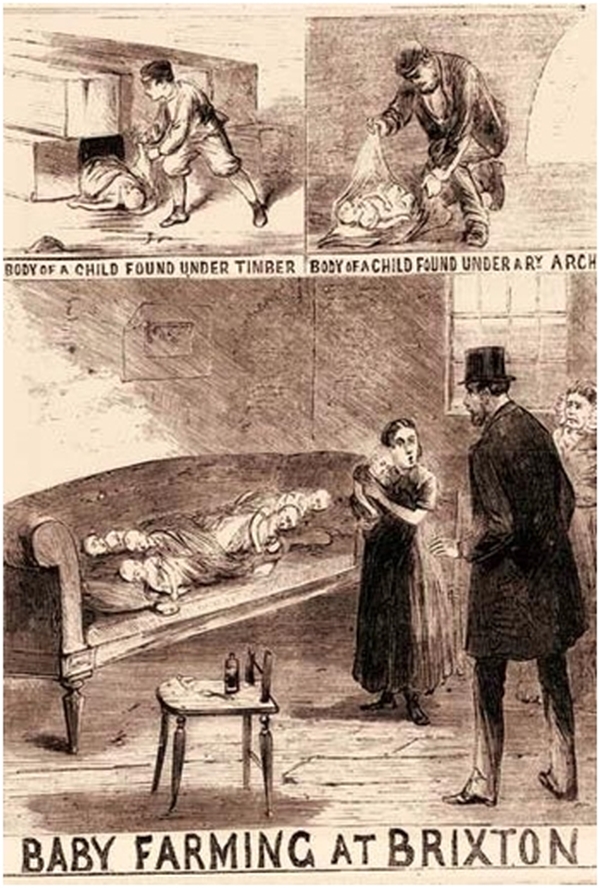
The Northern Daily of Thursday 6th February 1890 had a small article entitled ‘Baby Farming’ on the previous night’s meeting of the Stockton Branch of the Society for the Protection of Children in which a resolution was made in support of the Bill that was to be introduced for the regulation of baby farming. 200 baby farms were known to be running in the country. Some offered contracts where they agreed to kill a child in 6 months for £50 down and another £50 for a death certificate. Another undertook to kill in 3 months, £100 down with an understanding that no inquiries should be made. One woman advertised at Newcastle.
An edition of the Hartlepool Daily Mail of 1892 gave a report of an inquest on the death of Thomas Henry Cox aged 10 months, an illegitimate child whose post mortem examination showed the child to be terribly emaciated. The coroner was of the opinion that the child had been deprived of sufficient nourishment for a very long period and the cause of death was congestion of the lungs and malnutrition. The child had been put out to nurse with a Mrs Barlow for 3s6d per week and that the Society for Prevention of Cruelty to Children should be contacted to take the matter of this woman further as the child had died from neglect. Then in 1895 the paper gave details of an inquest held at the Lord Nelson Inn, Darlington on the body of a male child of about 3 weeks old. The child was the illegitimate son of Jeannie Foster a single woman who was employed at the woollen mills. Margaret Iceton, the midwife along with her daughter-in-law Jane Iceton took away the child on the evening of the 13th February a few hours after the birth accepting 4 shillings a week for looking after and maintaining the baby. The child was wrapped up in two shawls as it was very cold. The next night Jane Iceton and a woman called Foster, the aunt of the child took it to Dr Martin who told them bringing a child out in such weather could kill it. A few days later they returned to the doctor and asked him if the child died before he saw it would he sign a certificate for it. On Sunday Dr Martin went to see the child and found him nothing but skin and bone. He told them it was starved. The child died 2 days later. On post mortem the child was found to be 5lb instead of 8lb and there was no food in the body and he considered that the child had died of starvation. The verdict was manslaughter and the two Iceton women were charged and eventually were to serve 3 years in prison.
‘Baby Farming Near Shildon’ screamed the headline on the 28 March 1893 in the Northern Echo. Thomas and Elizabeth Ann Stephenson a young, well dressed couple were charged with neglecting and causing unnecessary pain to an infant at Middridge. Mr J.T. Proud was prosecuting for the N.S.P.C.C. Annie Cook, in service, the infant’s Mother arranged with the defendants to keep the baby for £11 10s. When weighed Inspector Sparks said the child was only 5lbs instead of a normal 12lb 4oz. The baby had burns on its legs with a swollen and distended stomach. Once fed correctly the child soon attained 10lb. The defendants were fined £5 each or one month prison. The sentence seems woefully inadequate for starvation and physical abuse.
In 1874 there was a suspected case of Baby Farming in Sunderland when an illegitimate baby called William Scanlan was found dead in Cross Green St. The child was about six weeks old and the single mother had placed it under the care of a woman in Waterworks Rd, when three weeks old. This same woman it was alleged had been in the habit of taking children in to nurse. Dr Francis was of the opinion that the death resulted from starvation and the police were informed.
Margaret Waters was an infamous ‘Baby Farmer’ who drugged and starved the children in her care. When finally brought to justice she was charged with 5 counts of murder as well as neglect although she was believed to have killed at least 19 infants. She turned to this unsavoury ‘career’ in 1864 after the death of her husband. The 5 deaths she was charged with were as a result of her feeding the babies opiates which resulted in diarrhoea, malnutrition and convulsions. Once dead, Margaret would wrap their tiny bodies in brown paper before disposing of them on the streets of Brixton.

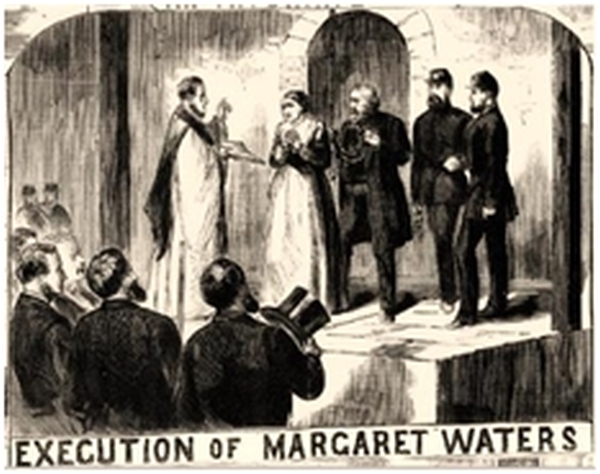
The police caught up with her over the death of John Walter Cowen, illegitimate son of 16 year old Janet Cowen. On inspecting her home the policeman wrote “Some half dozen little infants lay together on a sofa, filthy, starving and stupefied by laudanum”. There was a lengthy article in the Guardian newspaper on the 12th October reporting her execution the day before.

She did not betray any emotion when led to the scaffold and once the rope was placed around her neck she said a prayer and immediately afterwards dropped to her death. In her police statement she had revealed that some of the babies given to her for adoption were from more affluent families, delivered to her by gentlemen with a nurse. Being caught out with an unwanted pregnancy was not the sole domain of the poor young girl. Her sister Sarah Ellis was convicted in the same case and sentenced to 18 months
A woman was hanged at Newgate Gaol on the 10th June 1896 – the woman was Amelia Dyer the notorious Baby Farmer. She had been found guilty two weeks earlier at the Old Bailey for the murder of two babies.
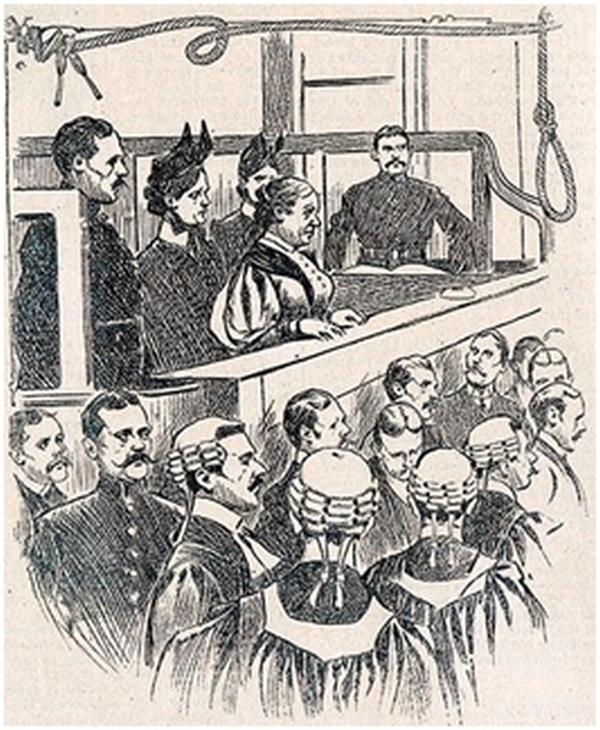
They had been strangled with tape, wrapped in brown paper and dumped in a carpet bag in the Thames at Reading. The police had their suspicions about Dyer in April when another child was found in the reeds on the river. The police discovered dozens of vaccination papers, huge amounts of baby clothes and pawn tickets for baby clothes. They found many letters and receipts for advertisements arranging adoptions under several aliases. There was a smell of decay emanating from the pantry and a trunk under her bed. Orders were given to drag the river watched by crowds of onlookers. The bodies numbered 50.
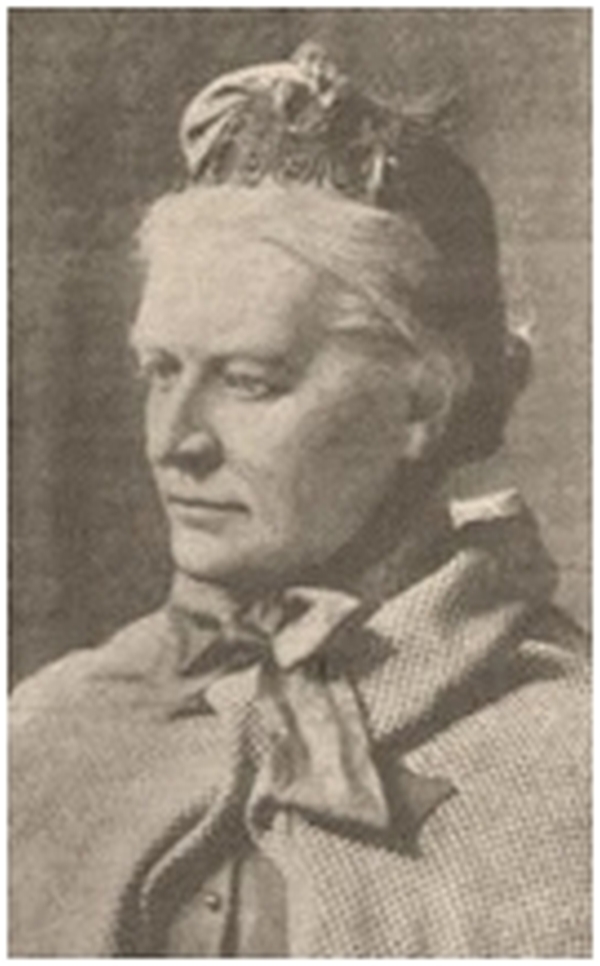


Dyer had been in business for 30 years travelling as far north as Liverpool and far south as Plymouth. At first she fostered children for a weekly fee whilst starving them and keeping them quiet with doses of laudanum.
Some years after and having spent 6 months in prison for child neglect she only accepted babies for full adoption in exchange for one large payment. After payment the infants were murdered by strangling them with tape and then dumped. How many did she kill? It is unknown, but eye witnesses described seeing as many as 6 children a day being taken in. Mrs .Dyer’s daughter said her mother was in the habit of advertising in the ‘Christian World’ for children to nurse…… The irony is not lost.
Many a young women in service would discover she was pregnant and try to hide her growing stomach right up to the birth in the fear she would lose her position and have no other choice but to seek refuge in the Workhouse. A very real dilemma along with the stigma attached to being a single mother. Where would she live? What would she live on? Would her family disown her?

In the Berwick News and General Advertiser in 1871 there was a report of a suspected infanticide when a naked baby girl was found on Spittal Point on the evening of the 9th by local fishermen. James Whiteford testified before the jury that he found the body lying on the sand with the water flowing about. He picked her up and took her to the Shield. Doctor Fluker the magistrate wanted to know about the tide at the time, but the man was unable to say. Doctor Jamieson informed the court that he’d made a post mortem examination of the child and found she had not died from natural causes and had been a healthy baby at birth. Death was from suffocation which might have been accidental. A week after the baby was found the body of a 27 year old local woman was found drowned on the same beach. She was lying about 20 yards from the edge of the water. Her clothes were very wet with a lot of sand on them and she had suffered slight abrasions to her face and knees. Family members described her as being in extremely low spirits for some time. A witness told the court that the victim had lost her job a few months ago working in the house of a local unmarried and affluent banker on Bridge St. and had not been able to find a situation. Dr. Fluker told the jury that the deceased had complained of flatulence and described her dismissively, as excitable. The verdict was drowning. How she got into the water there was no evidence to show. Local people assumed she was the unfortunate young woman who had secretly given birth to the baby. Whether it was true or not it is impossible to say, but Doctor Fluker served as a magistrate with the single banker and lived on the same street in Berwick as he did, so it can be assumed they knew each other. The single rich banker conveniently left the area not long after the bodies were discovered to live in Edinburgh and never returned. Flatulence as a cause of suicide or accidental death is ludicrous. Flatulence during pregnancy is common. One can but imagine how the tabloids of today would have treated the testimony of the good doctor.
Another report in the Newcastle Journal of 1870 described an infanticide at Wallsend on the body of a female child which had been found by a farmer in a field about 500 yards from his farm at Wallsend. Dr. Atchison judged that the child had lived 3 or 4 weeks and lain in the field 3 or 4 days before being found. A verdict of wilful murder against persons unknown was returned.
The Sunderland Echo in 1886 reported an infanticide when a baby girl was found floating in the Wear by some boys. And so the reports of the deaths continue – but out of all this horror an organisation was born The National Society for the Prevention of Cruelty to Children, which was originally founded in 1883 as the Liverpool Society for the Prevention of Cruelty to Children by Thomas Agnew a Liverpool businessman and in London by Rev. Benjamin Waugh and then throughout the country. The NSPCC was granted its Royal Charter in 1895 when Queen Victoria became its first patron. It is worth pointing out that the Society for the Prevention of Cruelty to Animals was founded decades earlier in 1824.
The welfare of children is closely bound to the welfare of women. It is hard to imagine but women only became ‘persons’ in their own right by order of the Privy Council in 1929, the year after women were given equal voting rights with men. Before that a woman was presumably categorised as merely a daughter or a wife. The introduction of the NHS in 1948 which gave everyone access to health care further improved the welfare of women and children. Prior to its introduction only the insured, usually men, benefited. In 1956 the Sexual Offences Act defined the crime of rape and in 1967 abortion was decriminalised and the backstreet abortionist was put out of business. That same year, the Summer of Love and Sgt. Pepper’s Lonely Hearts Club Band – the contraceptive pill and other methods of preventing pregnancy become available to all women in Family Planning Clinics regardless of the females marital status. Women for the first time had the right to choose when they were to start a family.
Written and researched by Dorothy Ramser
